Nature Conservation 2022 — 25. 5. 2022 — On Nature in the Czech Republic — Print article in pdf
Which Forest Is Formed by Spontaneous Processes in the Šumava/Bohemian Forest Mts.?
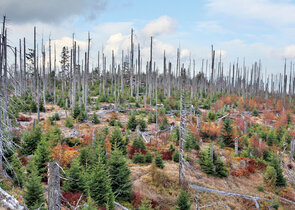
The thirty years of the Šumava/Bohemian Forest Mts. National Park (NP) have provided many findings – due to natural disturbances. European spruce bark beetle (Ips typographus) outbreaks culminated in 1996–1997 and 2009–2010, leading to a mass Norway spruce (Picea abies) decline in 1997 and 2011. But the European spruce bark beetle has left its traces until today, although to a lesser extent, just like a range of hurricanes. The result is that a quarter of the NP’s non-intervention area (approx. 18,000 hectares until 2019) is formed by stands with dead trees. Non-forest areas and peat-bogs account for about 22% and variously old stands dominated by spruce for the remaining 53%. The world of large spruce temples with tall column trunks has changed rapidly in a part of the territory.
Would Šumava be a spruce area after all?
For the past 9,000 years, the Šumava/Bohemian Forest Mts. have been dominated by spruce (Carter et al, 2018; Svobodová et al. 2001). It dominated and has still been dominating despite the fact that it has experienced many disturbances over this long period of time. After its minimum around the beginning of the Christian era (45–55% spruce) it had increased again and around the year 1500 it roughly reached its present level. The Central Šumava/Bohemian Forest Mts. were at that time practically bare, so the change in species composition could not have been caused by man. Likewise, man could not influence the decline in European beech (Fagus sylvatica) and European silver fir (Abies alba) share/dominance at that time (glassworks came later). Still in the mid-19th century, original primary/virgin forests represented a considerable proportion of today’s woodland in the national park and also these consisted predominantly of spruce according to descriptions of that time (Kruml 1964, 1968; Mayer 2013; Ministr 1963, 1969, 1964; Saitz 1898).
Biomonitoring – more than just a thousand permanent monitoring plots
We have searched for an answer to the question whether the position of spruce does not shake under the pressure of climate change in the recent period of predominant spruce by comparing the species composition of the tree layer (all trees with a trunk of more than 7 cm in diameter at breast height) and rejuvenation (all trees and shrubs of at least 10 cm high up to a trunk diameter of 6.9 cm at breast height) on permanent monitoring plots under the Biomonitoring project in an area of the Šumava/Bohemian Forest Mts. National Park having been left to natural processes since 2007. At the time of staking out the plots, a significant part of the area had been affected by large disturbances (felled and reforested clearings, stands uprooted by storms and forests with a mostly dead crown layer) or spruce trees were just dying due to the pressure of a European spruce bark beetle outbreak. With exception of Nature Conservation Zone I, afforestation was carried out in the NP, in which 54% of the permanent monitoring plots is located. Our results could therefore have been influenced by artificial plantings. But more about that later…
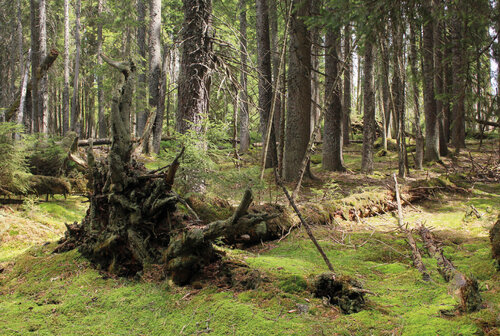
Waterlogged spruce forest on the Ptačí potok/Bird Brook stream. Rejuvenating spruce survive more easily on fallen trunks. © Pavla Čížková
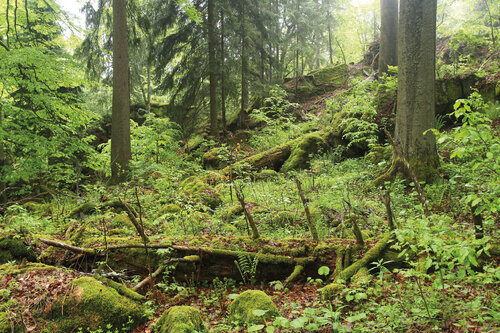
Mixed scree forests in former Zone I of the Stožec-Medvědice site. © Pavla Čížková
Natural rejuvenation is conservative (i.e. spruce-oriented)
In the area studied under Biomonitoring, spruce is responsible for 71% in the crown layer (living trees) or 76% if we add dry trees. Rejuvenation copies this trend uncompromisingly with 78% spruce. Beech (enumerated diameter 7 cm and more) is represented for nearly 9% in mature trees, and also 9% in rejuvenation. However, numbers and also shares/proportions of these two trees in rejuvenation are influenced by plantings. At present there are a total of 350 million rejuvenating individuals (based on an average rejuvenation density of 6,323 individuals/ha and a woodland area of 55,000 ha) on the territory of the national park. At the same time we know that 15 million trees have been planted in the NP since 1996. Even if all planted trees have survived, this represents only 4% of all rejuvenation.
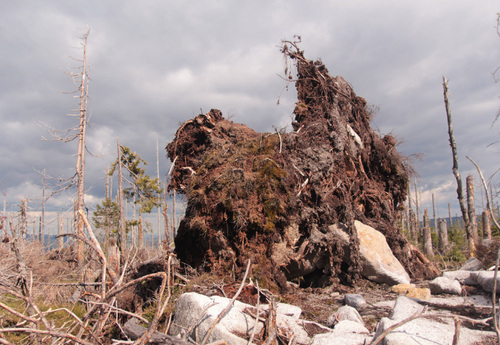
Windthrows reveal the shallow soil layer in which the giants were rooted at the top of Mt. Plechý. © Pavla Čížková
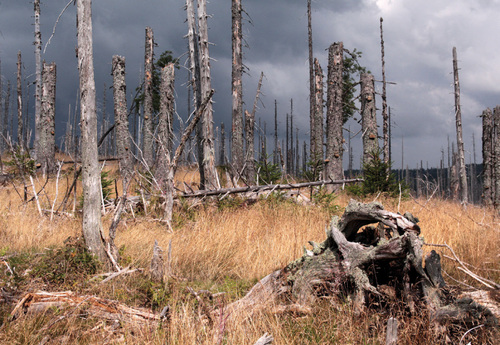
Slow onset of rejuvenation in the top part of Mt. Poledník. © Pavla Čížková
Is beech spreading?
The changing climate should provide beech with benefits from this change. Beech should occupy higher and higher elevations and spread from beech stands to the surroundings. Such a trend is locally indeed evident in the Šumava/Bohemian Forest Mts., but basically only in places with a higher amount of beech already today, e.g. around the village of České Žleby and on the slopes of Mt. Smrčina. Beech forests (defined as stands with more than 50% beech in the tree layer, not as surveyed potential vegetation) cover approx. 9% of woodland in the non-intervention area. They are mostly found at 800 to 1,200 m a.s.l., stands with 75% beech at an elevation of 950–1,150 m a.s.l., but not everywhere in the NP. Its occurrence is small-scale and isolated. Our measurements show that even natural beech rejuvenation reacts (by increasing its density) to a high proportion of beech at the crown level. Beech rejuvenation density increases with elevation up to 1,000 m, then rapidly falls down to zero. In contrast to spruce, beech prefers moderately steep slopes and avoids flatlands. It is almost missing on the plains in the central Šumava/ Bohemian Forest Mts., but also in the inversion valleys of the Křemelná and Vltava Rivers. In places where beech dominates in the main stand it rejuvenates most often, but spruce is the most common tree in rejuvenation also there. Areas with beech dominance form islets or strips on hill slopes. Beech spreads from its sources into the surrounding, but its expansion rate does not indicate that it could endanger the dominant position of spruce in the near future, not even after disturbance by wind or the European spruce bark beetle. Spruce can react to stand opening very quickly, becoming a strong and numerous competitor, also in the case that spruce rejuvenation has been delayed in comparison to already rejuvenated beech. This phenomenon was described by Antonín Klečka more than 90 years ago (Klečka 1934).
Will Šumava/Bohemian Forest Mts.’ spruce and beech forests change by climate change?
The ongoing climate changes in the Šumava/ Bohemian Forest Mts. are documented by a series of measurements. Results from the Bavarian Forest/Bayerischer Wald Mts. (Bernsteinová et al. 2015) show increased evaporation with unchanged annual precipitation caused by demonstrable warming (~2 °C). Based on repeated assessment of phytosociological relevés, a shift in vegetation towards species of drier habitats or heliophilous species has been described. These changes are however rather attributed to a reduction in canopy caused by storms and European spruce bark beetle outbreaks. The study from the Bavarian Forest/Bayerischer Wald Mts. predicted a considerable dying of the predominant spruce and fir due to rising summer droughts and winter temperatures. These species would gradually be replaced by beech. In contrast, Martínez-Vilalta & Lloret (2016) conclude in their critical assessment of vegetation changes that a clear change in vegetation could be demonstrated in only 8 out of 35 case studies. In three cases the original species composition was restored, but in the remaining 24 cases it could not be definitely decided whether a change in the vegetation cover will take place in the future.
That ‘repulsive’ spruce
Despite the fact that spruce is an autochthonous tree in the Šumava/Bohemian Forest Mts., some authors still regard it as an expansive domestic species and also as the greatest threat to natural forest vegetation there. They draw attention to the fact that it is difficult to distinguish autochthonous Šumava/ Bohemian Forest Mts. spruce populations from those which foresters have enriched the Šumava/Bohemian Forest Mts. with. Recently an extensive genetic study was carried out in the Bavarian Forest/Bayerischer Wald Mts. (Opgenoorth & Heer 2015), whose database is probably the largest set of population-genetic data on spruce. They compared the variability of spruce trees from various elevations in the Bavarian Forest/Bayerischer Wald Mts. And the results? Mountain spruces cannot be distinguished from lowland ones. There are no clearly autochthonous native mountain spruce populations! And there is another argument for spruce. Surprisingly, its current dominant position in the Šumava/Bohemian Forest Mts. National Park is in accordance with descriptions of forests in historical surveys of natural forests from the turn of the 18th and 19th centuries. The local high natural share/proportion of spruce in the tree layer was also described during the 19th century and in the early 20th century, and has been documented by a survey of primary/virgin forests during the 20th century.
Potential vegetation has a great potential for deviations
The term potential natural vegetation indi- cates vegetation which would be formed in a certain territory provided that any human intervention is excluded. In other words, it is the vegetation that would be expected given environmental constraints (climate, geomorphology, geology) without human intervention or a hazard event. Of all the plots surveyed in the Šumava/Bohemian Forest Mts. by the authors where spruce prevails in the current vegetation, 84% are located in units where spruce is mentioned as the only or a possible dominant in the tree layer. Of these, 37% are a part of the Calamagrostio villosae-Fagetum unit/association (acidophilous mountain spruce-beech forest), in which spruce is one of the possible dominants (Neuhäuslová et al. 2001). Although the description of acidophilous mountain spruce-beech forest allows spruce to be a dominant tree, this is not taken much into account. Authors in some notes doubt the dominant position of spruce even at localities which were in the early 19th century described as pure primary/virgin spruce forests with four-century old spruce trees (Bečka 2012). Probably a range of significant factors play a role there, different from the assumptions on which the potential natural vegetation is based. These are undoubtedly the influence of micro- and mesoclimate, but also historically caused forest dynamics or natural barriers to the spread of some species.
Change in species composition as an impossible dream?
All the time we feel that we are able to adjust species composition by artificial plantings. We want to help nature and step forward to a model species distribution. As we have seen above, artificial plantings have not changed species composition on the landscape level. But what about the local level? We have tried to verify the effect of plantings at three localities for which we have sufficiently precise information on artificial reforestation/afforestation.
One of them is the former Modravské slatě Reserve, a very large area which has practically not been exploited since 1996, except for plantings in Zone II. We know that nearly a million trees were planted there in the late 1990s – predominantly spruce, but also the rowan, beech, maple and birch, i.e. 1,152 trees per hectare. Fifteen years later we counted a total density of 3,165 rejuvenated trees per hectare, i.e. three times the number of trees planted there. Spruce was represented for 94%. The prevailing impact of natural rejuvenation is thus indisputable.
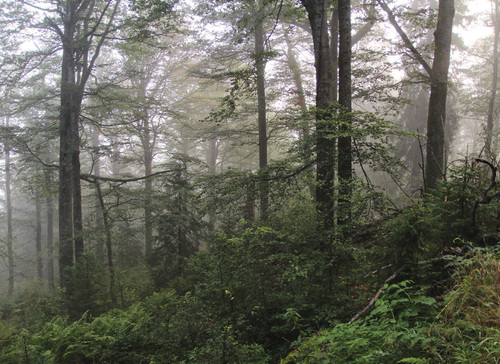
Beech forest on slope of Mt. Smrčina. © Pavla Čížková
Another area is a clearing originated from incidental felling east of Laka lake. There we counted rejuvenation 7 years after felling. Today an average of 5,135 rejuvenated trees per hectare are found there while the artificially planted trees, if they had all survived, would make up 15% of all trees. This already makes clear that natural rejuvenation prevails. Beech, fir, alder, birch, sycamore and pine trees, making up 47% of the planting, reach a proportion of just 5% in the resulting rejuvenation density. Spruce is already present for 58% today.
The third area is a clearing near the village of Lenora. The total rejuvenation density is 5,900 individuals/ha, the trees planted included beech (70%), fir (28%), the Wych-elm (Ulmus glabra) and sycamore (2% together). When assessing the origin of particular trees on the plots, we found the proportion of natural rejuvenation to be 80%, artificial planting 18% and rejuvenation of undetectable origin 2%. Although not a single spruce tree was planted there, its density reached a value of 891 individuals/ha and its share/proportion was 15%. The clearing also has three large fenced areas of various age (2010, 2012 and 2019). The rule seems to be that the older the fence or the longer the time since felling, the larger the proportion of spruce is. Fir has a share of 12% and beech 5%. Trees which we did not plant strongly dominate. An example is rowan, originating from natural rejuvenation only, rep- resenting 42%. Other trees are willows, aspen, birch, pine, etc.
Some questions to conclude
It has been demonstrated that artificial restora- tion is responsible for 15 to 40% in reforested clearings. It is true that we do not plant trees in such high densities as was the case in commercial forests, i.e. approx. 3,000 to 5,000 saplings per hectare. If we applied these rates, artificial restoration would probably reach a higher proportion.
This raises the following questions. Is this actually not the case with most Šumava/Bohemian Forest Mts. forests, with the felled and artificially reforested stands in which spruce prevails? Is the significant dominance of natural restoration over artificial restoration not an explanation for the conservatism of species composition, i.e. the constant dominance of spruce, and perhaps the resilience of forest species structure to the ongoing climate change? ■
- - -
Intro photo: Mountain spruce forests with patches of spruce and rowan rejuvenation in the top part of Mt. Plechý. © Pavla Čížková
- - -
List of referencies
Bečka P. (2012): Zapomenuté pralesy. Šumava: 12–13.
Bernsteinová J., Bässler C., Zimmermann L., Langhammer J. & Beudert B. (2015): Changes in runoff in two neighbouring catchments in the Bohemian Forest related to climate and land cover changes. Journal of Hydrology and Hydromechanics 63(4): 342–352. https://doi.org/10.1515/johh-2015-0037
Carter V. A., Chiverrell R. C., Clear J. L., Kuosmanen N., Moravcová A., Svoboda M., Svobodová-Svitavská H., Van Leeuwen J. F. N., Van Der Knaap W. O. & Kuneš P. (2018): Quantitative palynology informing conservation ecology in the bohemian/bavarian forests of central europe. Frontiers in Plant Science: 1–14. https://doi.org/10.3389/fpls.2017.02268
Klečka A. (1934): Význam buku ve světle vývoje šumavských lesů. Lesnická Práce 13: 1–9. http://lmda.silvarium.cz/view/uuid:283e79ca-ea15-4a88-a762-2ad35b021d0a?page=uuid:2c732fcc-c571-11e4-8912-001b63bd97ba
Kruml F. (1964): Historický průzkum lesů pro lesní závod Boubín (LHC Boubín a Strážný) a pro školní polesí lesnické mistrovské školy ve Vimperku.
Kruml F. (1968): Historický průzkum lesů pro lesní závod Prachatice. ÚHÚL Brandýs nad Labem.
Martínez-Vilalta J. & Lloret, F. (2016): Drought-induced vegetation shifts in terrestrial ecosystems : The key role of regeneration dynamics. Global and Planetary Change 144: 94–108. https://doi.org/10.1016/j.gloplacha.2016.07.009
Mayer E. (2013): Popis velkého plavebního zařízení na panství krumlovském v Čechách, vydaný v roce 1831 (Beschreibung der großen Schwem-Unstalt auf der herrschaft krummau inBöhmen). In J. Štemberk (Ed.), Schwarzenberský plavební kanál, historie a současnost (pp. 5–41). Správa NP a CHKO Šumava.
Ministr J. (1963): Historický průzkum lesů jednotného hospodářského celku Kašperské Hory I. a II. (ÚHÚL Plzeň).
Ministr J. (1969): Lesy a lesníci ze světa lesních samot. Naše Šumava.
Ministr J. (1964): Rozpad posledních pralesů na Sušicku. Minulostí Západočeského Kraje III: 156–169.
Neuhäuslová Z., Buryová B., Ložek V., Majer, J., Petruš J., Prach K., Procházka F., Sádlo J., Sofron J., Soukupová L., Svobodová H., Štech M., Vokoun J., Vorel J., Wild J. & Zatloukal V. (2001): Mapa potenciální přirozené vegetace národního parku Šumava (Z. Neuhäuslová (ed.)).
Opgenoorth L. & Heer K. (2015): Genetische Untersuchungen zu den Fichtenbeständen des Erweiterungsgebiet Nationalpark Bayerischer Wald. Universität Marburg, Fachbereich Biologie, Fachgebiet Ökologie: 1–12.
Saitz A. (1898): Popsání velkostatku Krumlova patřícího Jeho Jasnosti knížeti Adolfu Josefovi ze Schwarzenberga se zvláštním zřetelem na jeho lesy, mimo to popis vycházky České lesnické jednoty do lesů svrchu jmenovaných v roce 1898.
Svobodová H., Reille M. & Goeury C. (2001): Past vegetation dynamics of Vltavský luh, upper Vltava river valley in the Šumava mountains, Czech Republic. Vegetation History and Archaeobotany, 10, 185–199. https://doi.org/10.1007/PL00006930

